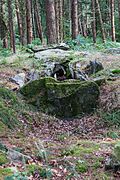Allée couverte by Corn-er-Houët
The Allée couverte of Corn-er-Houët (also called Dolmen de Corn-er-Houët ) is located in a forest northeast of Caurel , northwest of Mûr-de-Bretagne in the extreme south of the Côtes-d'Armor department in Brittany in France .
The Allée couverte from Corn-er-Houët is, especially in the access area, the best preserved gallery grave with side access ( French sépultures mégalithiques à entrée latérale ) in Brittany. The access was done by a soul hole , which peck through the two front panels of slate creates a round access.
The very off-center corridor is about 3.0 meters long. 21 orthostats that have been preserved form the supporting stones of the apparently slightly double trapezoidal chamber, about 10.0 m long and 1.2 m wide. Three mostly relocated capstones lie on the supporting stones. The end neolithic architecture of the 3rd millennium BC BC reminds of Nordic passage graves . The rock carvings of two opposing báculos can be seen on one of the gangway stones.
- Allée couverte by Corn-er-Houët
The gallery grave lies in an oval tumulus about 22.0 m long and 8.0 m wide, the edge of which consists of walls with small plates. The Allée couverte was classified as a Monument historique in 1998 .
The gallery grave Coët-Correc is about 1 km to the southwest .
See also
literature
- Jacques Briard : The Megaliths of Brittany. Translated from the French by Arnold Jacobshagen . Gisserot, Paris 2000, ISBN 2-87747-065-2 .
Web links
- Sépulture mégalithique dite dolmen de Corn-er-Houët in the Base Mérimée of the French Ministry of Culture (French)
- Description, pictures and sketches (French)
Coordinates: 48 ° 13 ′ 34.6 " N , 3 ° 0 ′ 28.6" W.





